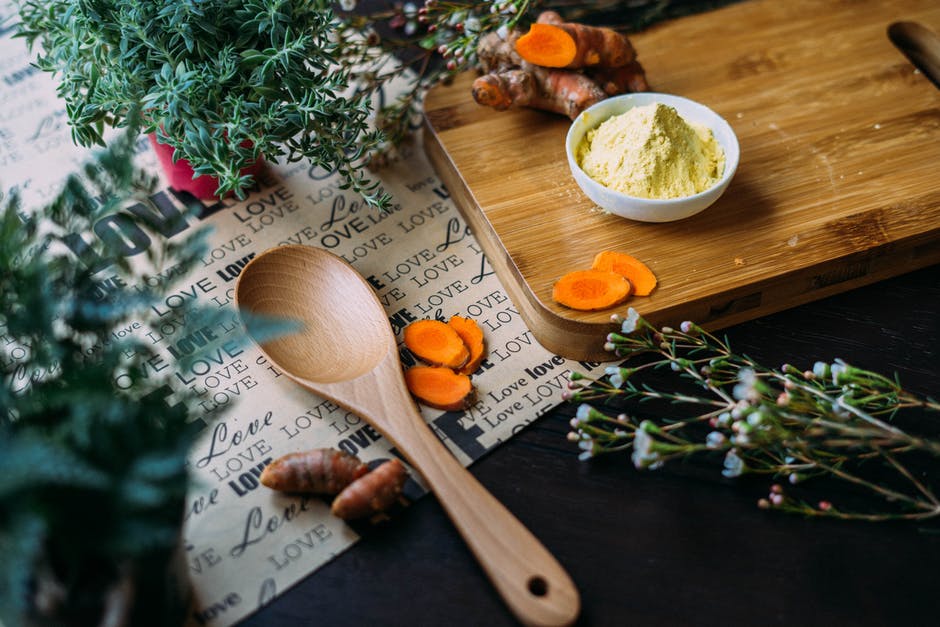For over 4,000 years, rich golden turmeric root has been valued and used extensively for its nutritive and medicinal properties. This prevalence has occurred especially due to its most useful component — the powerful antioxidant, curcumin. Turmeric, a relative of the ginger plant, is used widely in cooking (found frequently in mustard, as an integral element of of curry, and as color enhancement for butters and cheeses), as well as in traditional Chinese and Ayurvedic medicine. Studies have shown its likely efficacy (although some sources stress more research is needed) in fighting infection and some forms of cancer, as well as aiding with proper digestion, treating wounds and skin conditions, and reducing inflammation. Popular in the west over recent years, turmeric has shown up in the form of various teas, such as the rich and deliciously fragrant Golden Milk, as well as numerous other flavorful drinks and dishes. Turmeric’s lovely bright yellow color is attractive to most, but be forewarned: if you plan to use it, you may want to wear gloves. Its been known to stain fingers, and pretty much everything else it touches!
In addition to the above-mentioned health benefits, turmeric has other nutritional strengths — along with the accompanying science to back them up! It rates high on manganese content, for starters (we need that for wound healing), with each tablespoon providing over 100% of a woman’s RDA and over 80% of a man’s at 1.0 milligrams. It’s an optimal iron source too (needed for red blood cells to provide healthy oxygen transport throughout the body, and also generating energy), since over 65% of a man’s and 30% of a woman’s daily iron needs are met easily by a single tablespoon at a whopping 5.2 milligrams. On top of that, turmeric has been known to assist with the prolonged remission of ulcerative colitis, as an element of an Ayurvedic formula used to relieve pain, and as an age-old skin ailment remedy which has even been used inside the mouth for gum disease.
What’s more, there’s rumored to be brain-boosting, heart-protective, diabetes-fighting and possible arthritis-busting properties present in turmeric! Due to its curcumin content (curcumin is the most common and important of the curcuminoids), its health benefits and yellow color gain popularity. When combined with other ingredients, its absorption capabilities are enhanced nutritionally. For example, when mixed with black pepper (which contains piperine, which is also called bioperine), the effects of and absorption rate of turmeric is greatly improved (enhanced by 2000%, to be exact).
In regard to inflammation, studies have suggested that curcumin is remarkably powerful, matching the potency of some anti-inflammatory medications. One source explains that, on the molecular level, curcumin is bioactive, apparently blocking areas that “turn on” the genes for inflammation (while inflammation can be a good thing, prolonged inflammation is the targeted issue.) The root seems to work the same way with the development, growth and spread of cancer.
When studied for its effects against depression, turmeric found another way to wow us. A six week controlled trial measured curcumin against prozac among 3 groups of adults (one group took prozac only, the second took curcumin only, and the third took both substances together.) The study revealed the best results were experienced by the third group — the adults who took both prozac and curcumin together. Scientists explain that since depression has links to possible brain issues like a shrunken hippocampus (associated with learning and memory) or a low/imbalanced neurotransmission levels, turmeric can potentially target and reverse these.
Other uses for the golden ground root have included its being mixed with aloe vera into a paste for skin maladies like eczema or poison ivy. Teeth whitening aids, acne gels, and poultice preparations for pain, blisters, boils, or insect bites also rank high among its uses as a natural remedy.
Last but certainly not least comes turmeric’s potential connection to increased longevity. In the endless human battle against the inevitability of eventual death, turmeric stands up as a prevention of some leading killers like cancer and heart disease, as well as the development of neurological issues like Alzheimer’s. The science on it seems to say that because inflammation and oxidation appear to lead us into certain aspects of aging, curcumin’s targeting of those aspects may have the secondary effect of prolonging life in general. Any way you look at it, this amazing root has countless benefits and seemingly very little downside (aside from maybe a few yellow fingers after handling it!) Get some into your life today!

